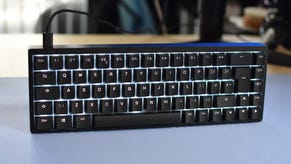Why You Don't Need More Than Four CPU Cores
More than four is less
We're back and this week I'm saving you even more money by telling you why you don't need more than four processor cores in your PC for gaming. You don't need more now. And you almost definitely won't need more for several years to come. What's, er, more, even if your cores are quite crusty, you're probably fine.
Back in the days when I was a bright-eyed, bushy-tailed young technology hack, Intel had a clear vision of the future. It would be multi-core. And not just any old multi-core. But massively multi-core. Yes, massively.
Two cores today, tomorrow four, then eight and 16. It would never stop. And why not? After all, that Moore's Law thing allows for a doubling in chip complexity roughly every two years. Spend that burgeoning transistor budget on cores and an exponential trajectory for core counts is inevitable.
Funnily enough, it didn't turn out that way. It was way back in 2006 that Intel launched its first quad-core desktop PC processor, which did indeed arrive roughly two years after its first dual-core model. Nearly a decade later, that's largely where we remain. Four cores.
Yes, Intel sells six- and eight-core CPUs for PCs. As does AMD. But Intel's offerings are really server chips rebranded and not for mainstream consumption. It's debatable, meanwhile, whether AMD's qualify as true six- and eight-core processors, if we're talking Bulldozer-based models, and the Hammer-based six core processors are now goners.
Anyway, even if you want to ignore all that and enter those six- and eight-core chips into the reckoning, we're surely still well behind schedule. For context, Intel is now doing server chips up to 18 cores. That's much more in line with picture Intel was painting back in the mid 2000s.
 Even supposedly CPU-intensive titles like BF4 usually don't scale well beyond four cores...
Even supposedly CPU-intensive titles like BF4 usually don't scale well beyond four cores...
However you slice it, then, we're well behind what the industry was predicting for core counts in desktop PCs. Then there's the fact that games consoles have actually gone further down the multi-core path than PCs. Both Xbox One and the PS4 have eight-core CPUs. Whatever you think of gaming consoles, they set the target for mainstream game development.
The final, most recent, piece of the puzzle is the upcoming DirectX 12 API which arrives with Windows 10, or more specifically the D3D12 graphics subset thereof. It's due to introduce a new rendering paradigm which Microsoft claims will allow game engines to spread their workload across multiple cores much more effectively and efficiently.
Put it altogether and being stuck on four cores for desktop PCs ought to be a major problem for gaming. And yet it isn't. Four cores is enough.
Let's start by quickly burying the console comparison. The AMD CPU cores in both consoles are pretty feeble. They do dramatically less work per operating cycle than even AMD's desktop PC cores, much less Intel's, and they're clocked well below 2GHz in both cases. In other words, a proper quad-core PC processor of almost any kind has those eight-core console chips squarely beaten.
I don't say that in the name of sneering PC elitism. I say that merely to underline that fact that the consoles' eight-core spec is irrelevant. Instead, what matters is that time and again, benchmarks show that frame rate scaling in games drops off as you go beyond four cores. That applies even when you are running the fastest graphics cards. The bottleneck beyond four cores is almost always the graphics, not CPU.
 Even DX12's multi-threaded shizzle looks unlikely to scale beyond four cores
Even DX12's multi-threaded shizzle looks unlikely to scale beyond four cores
In fact, it's not just that more cores than four isn't better. It's frequently worse. That's because most games simply won't make use of the additional cores and Intel's highest-clocked chips are quad-core, not six- and eight-core. In reality, the difference isn't enough to actually feel in games. Instead, it just helps drive the point home. Four cores is usually plenty.
Are there any exceptions? Running multiple graphics cards can see six-cores and beyond take a marginal lead in the benchmark tables. But then I've already explained why you don't want to run multiple graphics cards.
As for individual game titles, I'm sure some of you could find a game that runs faster on six or possibly even eight Intel cores. But they are very few and very far between. Check out these numbers on Bit-Tech for Battlefield 4, a game supposedly renown for scaling beyond four cores. Yup, thoroughly GPU limited.
Yes, you could probably find a setting with all the eye candy disabled where a six- or eight-core chip carved out an advantage. But it would all have to be pretty contrived.
If you're wondering about AMD's chips, if anything it's all simply worse. AMD's cores are weaker than Intel's and as things stand they're tough to recommend for anything but a very, very low-budget gaming box. AMD took a bet on multi-threading with its Bulldozer chips, and I'm afraid it didn't pay off, especially for gaming.
 An Intel Sandy Bridge quad or better means you're good to go for, well, pretty much good
An Intel Sandy Bridge quad or better means you're good to go for, well, pretty much good
But if there's anything that really convinces me that four cores are going to be enough not just today but also for the foreseeable future, it's some early benchmarking of DirectX 12. Anandtech has some benchmarks of Star Swarm, a demo designed to show DX12's new multi-threading prowess at its very best. And it shows zero benefit beyond four cores.
So, that's one reservation for the future covered off. DX12 doesn't seem likely to suddenly make six- and eight-core CPUs relevant. In the light of the awesomeness that appears to be Valve's new Vive VR headset, should or at least could virtual reality be another? Personally, I doubt it. The challenge regards rendering VR is primarily a problem involving big pixel grids and fast refresh rates. I don't seem dramatic new CPU workloads. So like other games, VR will be GPU limited, not CPU limited.
With all that in mind, all you really need to know is how old is too old when it comes to quad-core CPUs. There's an element of subjectivity here. But I'd say anything from Intel Sandy Bridge onwards – so that's Core i5 and i7 2000-series chips – are absolutely dandy.
To be honest, most of the time I suspect a high-clocked quad-core Nehalem chip – i5 7xx and i7 8xx and 9xx – would be hard to subjectively pick from the latest Intel Haswell chips, in-game, as these numbers suggest. It's not that Nehalem is every bit as fast as the latest CPUs. It isn't. But can you reliably tell 75 frames per second from 85 frames per second? I'm not sure I can. It's pretty remarkable given Nehalem came out in 2009.
Whatever, there you have it. If you have a remotely recent quad-core Intel CPU, certainly within four years old and probably within six, do nothing. All, for now, is well.








